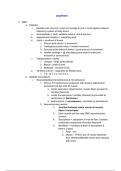Summary
Ultimate Chapter-to-Chapter CSCS Summary Outline
- Course
- Institution
- Book
Here's an outlined study guide of all 24 chapters of the book "Essentials of Strength Training and Conditioning - 4th edition" that's commonly used to study for the CSCS Exam by NSCA. This preparatory material will be helpful in understanding the most important big picture concepts in each chapter...
[Show more]



